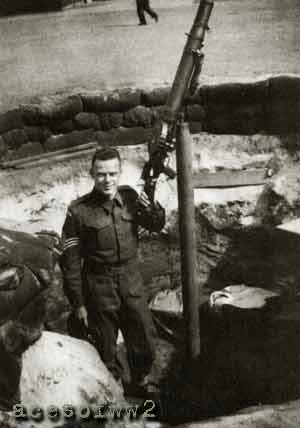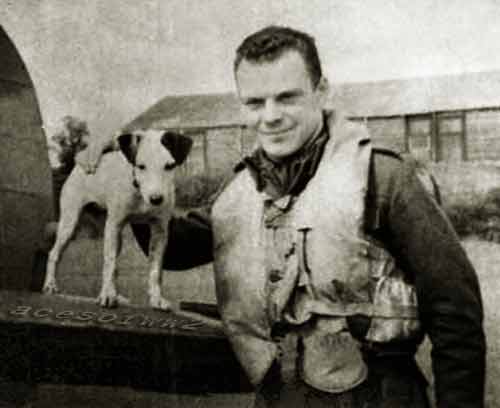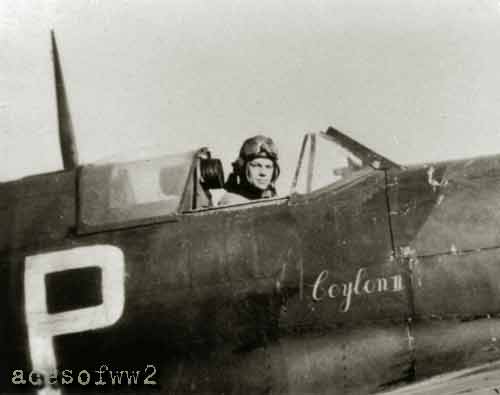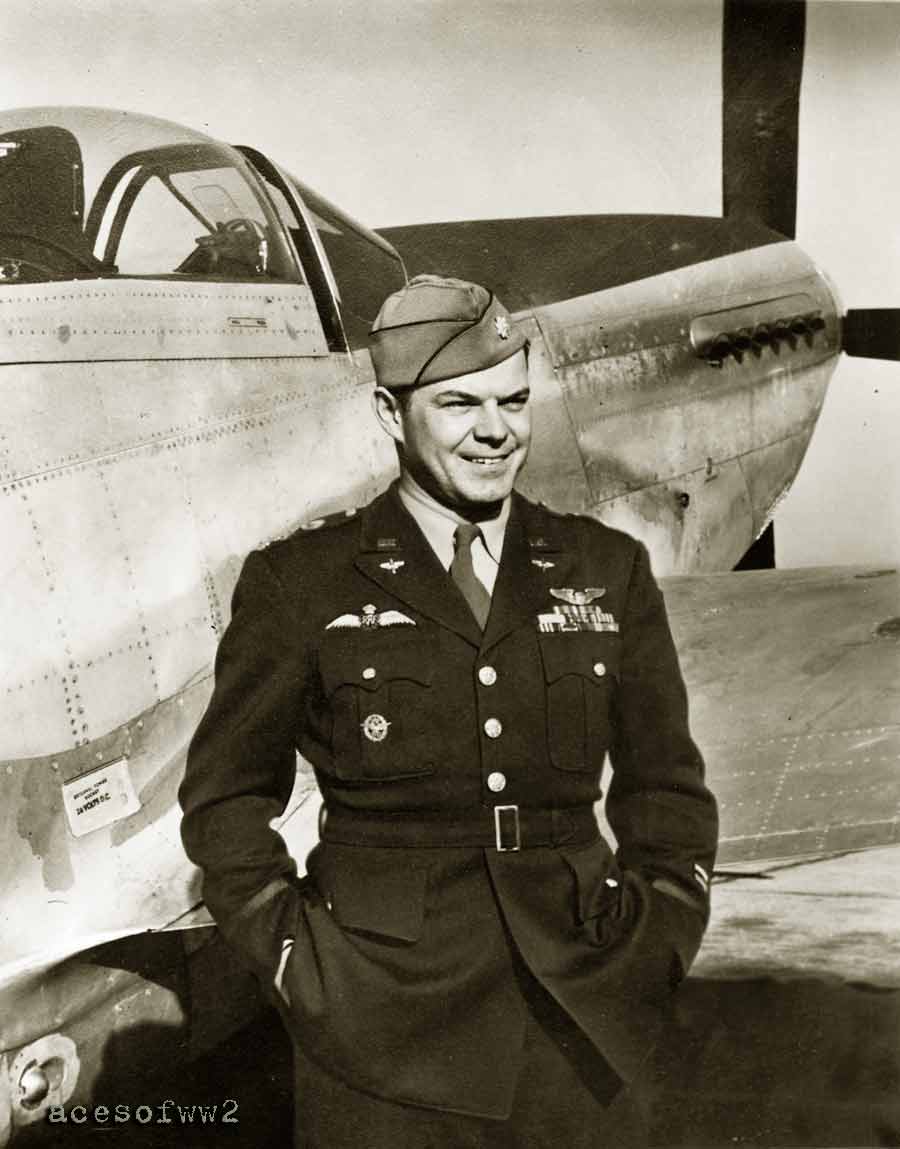|
_________________________________________________
On January 24th 1940, shortly after Dunn arrived in England as part of the 1st Canadian Division, their Brigade (The Seaforth's, Princess Pat's & The Loyal Edmonton's) was visited by King George -
"The next week all the officers and NCOs received a personal copy of a letter sent by King George to the General Officer Commanding, 1st Canadian Division. It read:Buckingham Palace
On behalf of the people of this country, I extend the warmest welcome to the first contingent of the Canadian forces to reach these shores.
The British Army will be proud to have as comrades-in-arms the successors of those who came from Canada in the Great War and fought with a heroism that has never been forgotten.
signed: George R.I.I still have my copy of King George's letter among my war service mementos." - from "Fighter Pilot" by Bill Dunn
_________________________________________________
Shooting Down Two Stukas
 Dunn with a (the?) Lewis gun |
I don't know why to this day, but I ran out of my bomb shelter to the unmanned post, where I set up the Lewis machine gun and readied it to fire. This antiaircraft position was a hole in the ground about five feet deep and maybe five feet wide, the parapet built up with sandbags for added protection to the gun crew. In the center of the pit was a thick wooden post with a swivel pin mounted on the top so the machine gun could be swung about and fired in a field of 360 degrees. The machine gun was a Lewis of the First World War vintage, its ammunition contained in round drums or pans of about forty .303 caliber cartridges each. The wounded ammo loader had crawled off to a bunker where he could get some medical aid. I glanced down at the gunner's corpse, his severed neck still gushing blood onto the ground. The gunner's head lay a yard or so from the sandbag parapet, the mouth agape, the dead eyes staring at nothing. I don't think any of what I was seeing at the moment registered in my brain. Now one of the Hun Stukas, flat out, came in a screaming dive toward my gun position, his forward firing machine guns flashing at me. Puffs of dirt, kicked up by his bullets striking near me, showered over me but I wasn't hit. Just as the Stuka began to level out, maybe 50 feet above the ground and at a range of some 200 yards, I sighted the old Lewis gun on the aircraft's prop spinner and fired a burst. I continued firing at the Stuka until it flashed over my head - all this in a few seconds. When the Hun pilot started his pull-up, his engine began trailing smoke and then burst into flames. The engine quit at a couple hundred feet, the nose went down, and the Ju87 crashed to the ground in a field a half mile from our camp. Later I found out that the two Krauts in the Stuka died in the fiery crash. I reloaded my Lewis machine gun. A second Stuka was now diving down on our camp, and it looked to me like he intended to lay a bomb right in my hole. I ducked down, flattening myself as best I could against the dirt wall and sandbags. I actually saw the bombs, two of them, fall clear of the Stuka. They hit the ground with a hell of a bang and blast, showering me with clods of dirt, stones and dust - near misses, damned near! As this Stuka pulled out of its dive almost directly over my gun pit, I took a good long deflection shot at it. The aircraft flew right through my bullet stream and I saw some of the bullet strikes on its engine cowling and fuselage. It seemed to falter in the air for a brief moment, then nosed down smoking, leveled out, and crash-landed. The other two Stukas were now flying away from the battle scene, back to Hunland. I was shaking like a leaf, my breath was coming in little gasps, my legs felt weak, so I sat down on the ground in the bottom of my gun pit. I was still sitting there when the medics came to collect the dead gunner. |
The two Germans in the last Stuka survived the crash-landing and were captured. Next day I took a couple packs of cigarettes to them when I paid them a visit at the hospital. The pilot, a young Feldwebel (Flight Sergeant) named Clausen, had his hands burned a bit. The air gunner - I've forgotten his name - had been wounded in the leg by a
.303 round. Clausen spoke pretty good English, and he didn't seem too sore at me for shooting him down. The other guy, a typical Squarehead bastard, wouldn't even thank me for the cigarettes. We two, Clausen and I, talked about flying for a while. He said he tried to become a fighter pilot, but got stuck in dive bombers. I told him that I wanted to be a pilot too, and how I got stuck in the infantry. Clausen wasn't a bad guy, for a Hun." - from "Fighter Pilot" by Bill Dunn
_________________________________________________
First Taste of Aerial Combat
"My first fight with enemy fighters occurred on an evening in late May, 1941. We got a squadron scramble and, after climbing to about 12,000 feet, were vectored out across the Channel toward the French coast. Here we ran into a squadron of German Messerschmitt Me 109Es patrolling their side of the Channel coast. We were some 3,000 or 4,000 feet above the Huns when Bill Taylor ordered us to attack. Being a new boy, I was totally unprepared, confused, frightened, and in near panic. One moment our squadron was flying in formation; the next moment they were all diving down to mix it up with the Krauts, leaving me sitting alone above the milling gaggle of fighting aircraft.
I remember that I cursed myself for holding back, even if it was just momentarily; then I too dived down into the melee. A 109 crossed my gunsight and I fired a long burst at it, without results. Range too far. Remember what Carey told you - short range, fill the windscreen, then fire! Now a stream of tracer bullets went whizzing past my cockpit hood - little glowing white-hot balls of fire - but I took no hits. I yanked the control column hard over to the left and back, and, hitting a high speed stall, went into a snapping spin.
By the time I'd recovered, well below the flight, I was all alone a couple of thousand feet above the channel waters. To be very frank, I'd had the bejesus scared out of me. My knees were actually shaking with fright. My grip on the control column was so tight that my fingers began to feel numb. The only thing I could think of to do was to get the hell out of there, fast, and safely home in one piece. I believe at that moment, for just that moment, I turned yellow, really yellow, a coward.
Flying back to the airfield I told myself I'd had enough of this air combat; I'd get a transfer back to the infantry somehow. Yes, I'd gladly carry that damned 3-inch mortar again from here to hell and back. Inwardly ashamed, I landed safely at Martlesham, the ignoble hero returned, I felt terrible inside, sort of sick to my stomach. Never in all my life had I experienced the anguish of such fear. I was thoroughly disgusted with myself. Maybe it would be best for the Royal Air Force to post me "returned home."
Actually, the fight between the two squadrons lasted for only a few minutes - it had gotten too dark. No one was shot down on either side, not even damaged, so it really wasn't much of a fight at all. After the brief fight, Uncle Sam Mauriello, joining up with the squadron to fly home, noticed they were going in the wrong direction. A quick glance through the darkening evening sky toward his wingman revealed that the other guy was flying an aircraft with a big black and white cross painted on the fuselage side, an Me 109! A startled glance to the other side confirmed to Sam that he was flying right in the middle of the German squadron. The Krauts must have seen the RAF roundel insignia on Sam's Hurricane at about the same moment, because everyone suddenly broke formation and scattered all over the sky. Uncle Sam did a split-S (roll on your back and pull the control stick back, dive down and pull out in the opposite direction) and headed for home, flat out, with six or seven Huns after him. After a brief chase they turned back toward France, probably short of gas. Sam's face was sort of green when he got back to Martlesham and told his story of the incident.
Well, my face was sort of green, too, after my poor showing in my
first air combat. Nobody, however, seemed to have noticed my "strategic withdrawal" from the fight, for which I was very thankful. Following our debriefings by Robbie Robinson, the intelligence type, I went quietly to my quarters, lay face down on my bed still fully clothed, and silently sobbed myself to sleep. I just couldn't believe myself to be a coward, I'd been in action against the enemy before. I'd been shot at many times, and bombed several times as well. Why should this terrible fear of air combat suddenly come upon me now?
After a fitful night, my dreams filled with shot-down aircraft - all on fire and burning furiously and I, the pilot, couldn't get out - I awoke at dawn, my entire body covered by a cold sweat. Sitting on the edge of my bed, my aching head cupped in my shaking hands, I began anew to silently curse myself as a gutless bastard. "You can't quit," I told myself, "You've got to get hold of yourself. If these other guys can do it, so can you. Those goddam Squareheads aren't any better trained than you are, and they're probably just as scared too. You are not going to quit, you stupid, yellow son of a bitch!" And I hit myself hard in the jaw - not just once, but several times until it really hurt.
I was not scheduled to go on readiness until noon that day. After a cold shower and a bit of breakfast, I walked out on the airfield to the squadron dispersal hut. There I checked the Form 400 on my Hurricane, telling the maintenance officer I was going to take her up for a flight of an hour or so. The day was beautiful and sunny, with a high, clear blue sky.
After takeoff I climbed and climbed and climbed toward the heavens, leveling out at about 25,000 feet. There I flew in a great wide circle, being able to look down from my height on a large part of eastern England, the whole width of the Channel, and the distant
French coast. And there I gave myself a furious tongue-lashing. I talked to myself and I talked to God. Yes, I really prayed for Him to give me the mental and physical strength I needed to face my ordeal with courage. At that moment, in the high untrespassed sanctity of space, I believe I really did put out my hand and touch the face of God. A great calmness seemed to descend upon me; I could feel a powerful strength surge through my body. And from that moment I knew my prayers had been answered. I was a new man, a man reborn.
I laughed aloud at my past fears of combat flying. The wings of my Hurricane began to feel like they were a part of my body, gracefully flashing and wheeling through the bright sky. The Merlin engine began to throb in unison with the quickened blood that pounded through my veins. The absolute thrill of flying settled firmly upon my whole being, and I became one with my aircraft.
Gently I turned my Hurricane over on her back and began my descent in a long series of slow rolls, entered the airfield circuit, and made a wizard landing - not even one small bounce, a grease job. I was free - completely free - of my fears. Now I could proudly hold up my head and look any SOB right in the eye. I knew I had the guts, once again, to stand up against anything. Bring on those Hun bastards! Have no fear, Dunn is here!" - from "Fighter Pilot" by Bill Dunn
_________________________________________________
Pipsqueak & The Eagle Squadron Movie
"August proved to be a month of contrasting events — some good, some bad, some in between. To begin with the bad events, elderly Air Chief Marshal Sir Hugh "Boom" Trenchard, the father of the Royal Air Force and its first Chief of Staff, paid an inspection visit to No. 71 "Eagle" Squadron at North Weald, "To meet our very first American allies," he said. Well, we had a terrier-mix dog, our squadron mascot, named "Pipsqueak," who didn't approve of all the pomp and ceremony of this inspection nor of the inspecting officer. Commented Sir Hugh when he returned to the safety of Air Ministry's Adastral House; "That damned dog of the Americans ran up to me when I was taking the salute during their march past and bit me on the leg!" Pipsqueak was never awed by rank. Thank goodness the inspecting officer that day wasn't King George VI. Once, when the station commander was visiting our squadron dispersal hut, Pipsqueak urinated on the leg of the chair in which the group captain was seated. Shortly after this, a Hollywood movie called Eagle Squadron was to be previewed in London. The whole squadron was released from alert readiness and all the pilots directed to attend this first showing at a little theater near the Strand Palace Hotel. We were given two rows of reserved seats up front, the rest of the seats being filled with senior British military officers and some high-ranking civil service types. The movie was bloody awful, the plot was all BS; to be frank, it stank to high heaven. |
 The mighty Pipsqueak & Dunn |
_________________________________________________
News Brief
27 August 1941 - His foot injured by a piece of a Messerschmitt's canon shell, a big hole in the fuselage of his Hurricane and his radio-telephone smashed, an American Eagle squadron pilot landed safely baok in England today after an offensive operation over Northern France in which he shot down two Me.109's.
_________________________________________________
Texan Downs Two Nazis As R.A.F. Attacks Grow
 Dunn in the cockpit of a Spitfire named "Ceylon II" |
London, 28 Aug. 1941 (Thursday) (BUP) - Royal Air Force bombers battered German defenses and other targets across the Channel last night and were believed to have struck at enemy shipping in the Strait of Dover. William Robert Dunn - of Texas went hunting German planes yesterday, found them plentiful over France and shot down two. He then took his fighter plane back to its base before repairing to a hospital for treatment of a foot wound. Dunn, who hailed from Houston, Texas, when he joined the American Eagle Squadron of the Royal Air Force, took part in two sweeps of Northern France, and with his bag of two enemy planes boosted his total to four. Announcing Dunn's feat, the Air Ministry said his wound was slight. He was in the second sortie across the coast in early morning offensives by "many squadrons" of Spitfire and Hurricane fighter planes. Because of ‘trouble’ with his oxygen equipment, Dunn was forced to fly lower than the rest of his squadron on the way back from France. He was attacked by three Messerschmitts. The first German overshot and Dunn gave him a burst, causing him to bail out. The second attacked, but burst into flames and crashed. The third hit Dunn's fuselage and radio-telephone and a piece of cannon shell entered his foot. Even before he became a member of the Royal Air Force, Dunn shot down two German planes, the Air Ministry said. He was a member of a Canadian infantry regiment stationed in South England when, with a Lewis gun, he downed two dive bombers attacking the camp. The daylight raids followed a night attack on Cologne, German industrial city, which the Ministry indicated was unusually effective. |
The Ministry said the attack upon Cologne was "on a somewhat larger scale than of late," and caused great explosions and fires visible for fifty miles.
Ten German fighters were destroyed in the sweeps over France, the British said, while eight British planes admittedly were missing. Four enemy planes were downed in the second attack in which both American Eagle Squadrons — the one organized nearly a year ago and the second added to it recently — took part.
Two R.A.F. fliers collided over the French coast, the Ministry announced. One pilot managed to fly back to his station but the other had to bail out.
In the first of two sweeps, more than 100 Messerschmitts met R.A.F. formations, the Ministry said. An Australian squadron, which attacked repeatedly, shot down three Messerschmitts. An Irish holder of the D.F.C. (Paddy Finucane), the only non-Australian in the squadron, got two of them.
Supplementing the communiques on the Cologne raid, the Air Ministry said the city had been hit so hard that alternative methods of travel were being advertised and theatre programs cancelled. A district south of the city was reported without gas and water for a week.
One night in July, 100 freight vehicles were destroyed, and many trucks and carriages still were burning the next morning. Several warehouses of the Rhine Shipping Company were burned out or badly damaged.
_________________________________________________
Uniformed Thousands Welcomed to Canada
2 December 1941 - Flying Officer Billy Dunn, an original member of the Eagle Squadron, is on his way back to Dallas, Texas, on sick leave after being knocked out in a single-handed battle with seven Nazi planes during which he downed two enemy aircraft. Although he managed to get his plane back to his base, Dunn was blinded temporarily by a head wound and:
"I thought I was finished and sat there waiting for the crash. All I could think of was that some other guy would take my girl to the dance that night. That sounds nutty, but it's true." His sight returned in time to let him land the plane.
His foot smashed by shrapnel during the battle, Dunn had several toes amputated and now limps slightly and carries a cane.
_________________________________________________

_________________________________________________
Victories Include :
| 16 Aug 1940 2 July 1941 6 July 1941 21 July 1941 9 Aug 1941 27 Aug 1941 ?? 1944 ?? 1944 ?? 1944 ?? 1944 30 May 1944 18 June 1944 28 July 1944 |
two Ju87s one Me109 1/2 Me109 one Me109 one Me109 one ME109 two Me109s one Me109 one FW190 one FW190 one FW190 one FW190 one Do17 one Me110 4 u/i e/a |
destroyed [1] destroyed (Circus 29) [2] probable (Circus 35) [3] destroyed (Circus 54) destroyed & damaged (Circus 68) destroyed & damaged (Circus 86) destroyed (unconfirmed) destroyed (unconfirmed) destroyed (unconfirmed) probable destroyed [4] destroyed [4] destroyed OTG |
6.5 - 6 / 5 - 5.5 / 13 - 2
plus 4 On The Ground
[1] With a Lewis gun while a
Canadian Infantryman in Southern England. Does not count in his score 1 (+ 4 unconfirmed [go with probs]) after transferring to the 406th Fighter group USAAF |
_________________________________________________
China 1946
"One night, about midnight, when Pete Abbott and I were driving from the airfield to Peking, I saw a roadblock ahead of us. As Chicom infiltrators were active in the area, I always carried a .38-caliber pistol close to me on the car seat. This night, in the car's headlight beams, I could see several armed Chicom troops manning the barricade. They knew we would have to pass this way on our way into town. There wasn't much of a choice for Pete and me - we had to fight or get rubbed out.
I poured the coal to our old Chevy, heading for the barricade full bore with the horn blowing. Lots of noise makes for confusion in a situation like this. With my left hand on the steering wheel, I took the .38 in my right hand, stuck the pistol out the driver's window and, as we smashed through the barricade, began pulling the trigger. We went through them like a dose of salts, scattering Chicoms in every direction, and then barreled on down the road. I don't think they even got a shot off at us. We immediately reported the incident to the commander of the Peking Chinat garrison, who dispatched his troops to the scene. They found the barricade, but no Chicom troops; however, they did report that quite a bit of blood was scattered about the area.
This incident, of course, was reported to MAGIC headquarters in Nanking. A few days later I was ordered to withdraw my guys from advisory service with the 4th Fighter Group. There seemed to be a Chicom pattern set up for the assassination of all American advisors to the Chinat Air Force. The advisor withdrawal instructions, I was informed, came direct from General George C. Marshall of the Joint
Chiefs of Staff in Washington, D.C. It's too bad the general couldn't see how his action would affect the near future of China, and the distant future of all of Asia." - from "Fighter Pilot" by Bill Dunn
_________________________________________________
Favourite Quote from his book "Fighter Pilot":
"...one time I got this Fokker on my tail - this Fokker was flying a Messerschmitt 109..."
_________________________________________________
Back to --- American Aces --- |
Related Sites :
|
_________________________________________________
Thanks go out to
On these pages I use Hugh Halliday's extensive research which includes info from numerous sources; newspaper articles via the Canadian Museum of Civilization Corporation (CMCC); the Google News Archives; the London Gazette Archives and other sources both published and private.
|
Some content on this site is probably the property of acesofww2.com unless otherwise noted.
![]()

